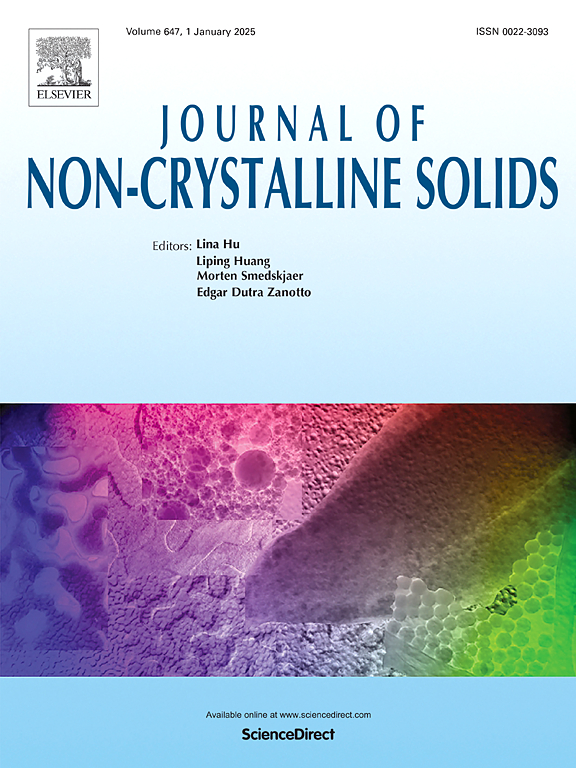Impact of replacing Na+ with Ag+ on the optical and spectroscopic properties of Er3+-doped tellurite glasses
IF 3.5
3区 材料科学
Q1 MATERIALS SCIENCE, CERAMICS
引用次数: 0
Abstract
Er3+ doped tellurite glasses have attracted significant interest due to their broad emission band at 1.5 µm, the telecommunication window. Among them, the glasses in the TeO2-ZnO-Na2O system are particularly suitable for waveguide fabrication using ion exchange. This study investigates the impact of substituting Na2O with Ag2O in the tellurite glass doped with Er3+ ions on its optical and spectroscopic properties, as well as its chemical durability when immersed in AgNO3-KNO3-NaNO3 molten salt baths, usually used for Ag+-Na+ exchange. The replacement of Na2O with Ag2O leads to an increase in thermal stability and refractive index due to the depolymerization of the glass network. When immersed in Ag-containing salt baths, the glass surface reacts with the molten salt bath, the reaction of which depends on the glass and molten salt bath composition. Diffusion of Ag+ and preferential etching of TeO2 can be obtained, as well as surface crystallization. The glass with the composition 80 TeO2 – 10 ZnO – 10 Na2O (in mol%) was found to be the most stable in the molten salt bath probably due to its polymerized network and so the most suitable glass for ion exchange processes and waveguide fabrication.
Ag+取代Na+对Er3+掺杂碲酸盐玻璃光学和光谱性能的影响
Er3+掺杂碲酸盐玻璃由于其在通信窗口1.5µm处的宽发射带而引起了人们的极大兴趣。其中,TeO2-ZnO-Na2O体系中的玻璃尤其适合于利用离子交换技术制造波导。本研究研究了在掺Er3+离子的碲酸盐玻璃中,用Ag2O取代Na2O对其光学和光谱性能的影响,以及浸没在AgNO3-KNO3-NaNO3熔盐浴中(通常用于Ag+-Na+交换)的化学耐久性。用Ag2O代替Na2O,由于玻璃网络的解聚,导致热稳定性和折射率的增加。当浸入含银盐浴时,玻璃表面与熔盐浴发生反应,其反应取决于玻璃和熔盐浴的组成。得到了Ag+的扩散和TeO2的优先蚀刻,以及表面结晶。80teo2 - 10zno - 10na2o (mol%)组成的玻璃在熔盐浴中最稳定,可能是由于其聚合网络,因此最适合离子交换工艺和波导制造。
本文章由计算机程序翻译,如有差异,请以英文原文为准。
求助全文
约1分钟内获得全文
求助全文
来源期刊

Journal of Non-crystalline Solids
工程技术-材料科学:硅酸盐
CiteScore
6.50
自引率
11.40%
发文量
576
审稿时长
35 days
期刊介绍:
The Journal of Non-Crystalline Solids publishes review articles, research papers, and Letters to the Editor on amorphous and glassy materials, including inorganic, organic, polymeric, hybrid and metallic systems. Papers on partially glassy materials, such as glass-ceramics and glass-matrix composites, and papers involving the liquid state are also included in so far as the properties of the liquid are relevant for the formation of the solid.
In all cases the papers must demonstrate both novelty and importance to the field, by way of significant advances in understanding or application of non-crystalline solids; in the case of Letters, a compelling case must also be made for expedited handling.
 求助内容:
求助内容: 应助结果提醒方式:
应助结果提醒方式:


